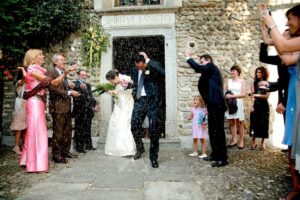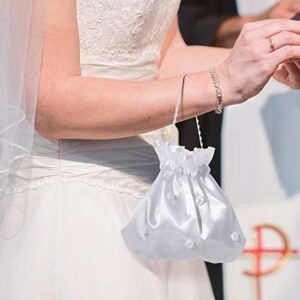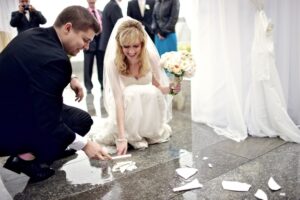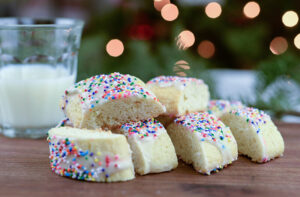Italian Wedding Traditions – Buona Fortuna!
Are you looking to make your wedding a little more Italiano? Whether you want to make your Sicilian grandparents proud or you just have a hankering for some mouth-watering lasagna, Italian weddings are known around the world for their boisterous, festive nature. Grab a sparkling glass of Prosecco and read on to discover more ways to bring your celebration a taste of Italy.
The Bride’s Ensemble
Since the marriage ceremony is traditionally the first time the couple sees each other in full wedding regalia, it’s considered bad luck for the bride to wear her complete wedding outfit before the big day. Leave a little something, like a bracelet or a garter, to add right before they walk down the aisle, especially if you plan to look in a mirror beforehand. It may also come as a relief to learn that it’s considered bad luck for a bride to make her own wedding dress; now you have a reason to spring for that darling number you saw in the boutique window.
Many Italian brides choose to incorporate a bit of green into their wedding outfit. The color represents fertility and good luck; in fact, historically, many Italian bridal dresses were entirely green. If you’re dressing for luck, don’t wear any gold until the gold wedding band has been placed on your finger.
Don’t forget la borsa, the satin bag used to collect bridal gifts at your reception. Traditional Italian wedding guests know to slip envelopes of money into the small purse so they can help pay for the lavish celebration. If you feel uncomfortable requesting this of your non-Italian friends, simply carry the purse as an option for more traditional guests to partake.
Iron and Glass for Luck
Traditionally, the Italian groom carries a bit of iron in his pocket on his wedding day to ensure good luck. If you don’t want a heavy chunk of metal weighing you down, consider creative alternatives like a single pill of an iron dietary supplement or a piece of iron jewelry.
Another way to ensure good luck at an Italian wedding is to break a glass when the reception is over. Be sure to shatter it thoroughly; the number of shards it breaks into will signify the number of happy years the marriage will enjoy. You may want to start a chant of, “Per cent’anni,” “for a hundred years!”
Your Italian Wedding Menu
What could represent our Italian wedding traditions article without introducing the Italian tasty food in?
Half the fun of attending an Italian wedding is getting to feast upon one of the most delectable cuisines in the world. Tantalize your guests ahead of time by dropping hints as to what Italian delicacies you might serve. (Don’t forget to hire a fantastic caterer to back up your claims!) Serve as many courses and dishes as possible to treat your attendees to a feast they’ll never forget.
Begin with antipasto, a traditional first course signifying that the formal Italian meal has officially begun. Pile platters high with cured meats and olives, stuffed or marinated mushrooms and artichoke hearts, a selection of Italian cheeses, and anchovies. If you’re expecting vegetarian guests, you may want to serve some antipasto platters that are heavy on the pickled vegetables, cured olives, and other non-meat offerings.
If you want to serve a pasta course, your choices are nearly endless. From tomato-simmered tagliatelle to garlic-pesto linguini, and cheese-stuffed agnolotti ravioli to spaghetti alla carbonara, Italian pastas can also serve easily as a main dinner course. Don’t forget the ever-popular potato gnocchi and traditional lasagna.
Popular Italian main dishes center around tender, roasted meats like suckling pig and lamb rubbed with herbs. Seafood stews are popular choices when served alongside garlic bread. Vegetarian options include eggplant parmigiana (though it does contain cheese) and the savory Tuscan vegetable soup, ribollita (which does not). Finally, it goes without saying: don’t forget the pizza and the Italian wines!
Italian desserts are well-received even if you’re not incorporating any other aspects of the culture into your wedding. You can serve crunchy biscotti with your coffee course, creamy cannolis (though these may inspire a tableful of Godfather quotes), layered tiramisu, or thick tortoni ice cream. Wanda (twisted, sugared dough) is a traditional wedding treat. Serve sweets with an espresso course, and don’t forget the powdery, sugared Italian wedding cookies!
Italian Wedding Traditions: The Wedding Cookie Dance
If you’re serving cookies, one fun Italian tradition to incorporate is the “wedding cookie dance.” Instead of serving your cookies on a flat platter, stack them into a cake-shape and present them on a table in the middle of the room. You and your newlywed spouse can then lead a dance to the cookie table, encouraging your guests to join in. (Picture a conga line, but more delicious). As each person passes the cookie table, they take a cookie. This is one dance where it’s impossible to forget the steps!
Another Italian dessert tradition is to provide guests with mesh baggies of candy-covered almonds, referred to as “confetti” because the guests are expected to toss the baggies at the couple in place of rice. Some couples (perhaps because almonds are considerably heavier than rice or birdseed) opt to give the confetti almonds as favors instead. As you prepare the bags, parcel out odd numbers of candy almonds in each to ensure further good luck.
For further reference, I will add the well-known Italian wedding scene from “The Godfather” movie:
Your Italian wedding will be a memorable event for all involved. As you depart your wedding, instead of painted windows and strings of cans, your getaway car can be decorated Italian-style with fresh flowers. (Isn’t that more pleasant to clean afterward?) Encourage your guests to eat, drink, and be merry–a true Italian wedding just wouldn’t be complete without someone’s boisterous uncle launching into a chorus of “Besame Mucho.” Above all, remember to relax and have a wonderful time with your gathered friends and family. Buona Fortuna!





